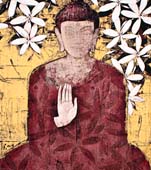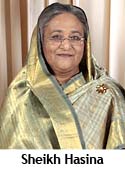For many thousands of years a long list of regional empires and European traders fought for control of the waterlogged land now called Bangladesh (formerly called East Pakistan).
Prior to the 6th century AD, the Gupta Empire commanded much of the Indian subcontinent, before being divided between the Gauda kings in the west and the Vanga Kingdom in the east.
Following a small rush of power, Bangladesh fell into an era of conflict and foreign invasion.
 In 750, Gopala became the first ruler of the Pala Dynasty, the first independent Buddhist dynasty ofBangladesh. It prevailed for four centuries, providing an era of stability and prosperity.
In 750, Gopala became the first ruler of the Pala Dynasty, the first independent Buddhist dynasty ofBangladesh. It prevailed for four centuries, providing an era of stability and prosperity. Vijay Sen annihilated the final Pala emperor during the 12th century, and re-introduced Hinduism to the region; Sufi missionaries arrived a short time thereafter, introducing Islam.
Numerous dynasties fought for control through the next several hundred years including the Turks, Hussain Shahis and Mughals, and then Murshid Quli Khan abolished the Mughal's in 1717, opening the door for Islamic dynasties to gain control.
In 1757, the British East India Company took over following the Battle of Plassey, and transformed the region into a trading post for bamboo, tea, sugar cane, spices, cotton, muslin and jute. Power was transferred completely to the British crown after the bloody Sepoy Mutiny of 1857, and Bangladesh fell into a downward spiral.
Adding to the increasingly weakened state, famine struck South Asia hard in the following decades, with the Great Bengal famine in 1943 - claiming the lives of more than three million.
Bangladesh was ruled by Britain throughout the 19th and 20th centuries. In 1947 the country was partitioned along religious lines after the British retreated. Western territory was relinquished to the newly created India, while the eastern side became a province of Pakistan.
It wasn't long before dissatisfaction of Pakistan's ruling emerged, and throughout the 1950s and 1960s Bangladesh pushed for autonomy.
Problems grew worse when a powerful cyclone struck the coast of East Pakistan, killing nearly half a million people in 1970.
Bangladesh finally cut ties, and seperated from its union with West Pakistan in 1971. However, an internal struggle persisted with the public and their new leader, Lieutenant General Hossain Mohammed Ershad of the Awami League.
When Ershad was forced to resign in 1990, following a major revolt which included all political parties as well as the public, Bangladesh reverted to a parliamentary democracy.
Nevertheless, the Awami League (which was installed shortly after independence in the 1970s) won the election of 1996.
 During elections at the start of the new millennium, the Awami League lost against the Bangladesh Nationalist Party, but regained control (much to the disbelief of the public) in 2009 after a landslide victory won by Sheikh Hasina.
During elections at the start of the new millennium, the Awami League lost against the Bangladesh Nationalist Party, but regained control (much to the disbelief of the public) in 2009 after a landslide victory won by Sheikh Hasina. The past few years have seen crippling opposition protests, strikes, transport blockades and leaving over 180 people dead.
In the 2014 election, Sheikh Hasina was elected to a third term. At least 26 people were killed during the election making it the bloodiest vote in the history of Bangladesh.
As one of the most crowded countries on the planet, much of the lush, low-lying landscape is subject to yearly flooding, and the subsequent devastation of cyclones.
Those natural hazards have adversely affected the nation's economy and its people, as they often cause great loss of life. Of the 154 million residents of Bangladesh, at least one-third live below the poverty line.
Not on the front-burner of most travelers, reports from those who venture here rave about its natural beauty, the friendly welcome, the capital city of Dhaka, and the easy-going beach resort of Cox's Bazar - home to the world's longest beach
No comments:
Post a Comment